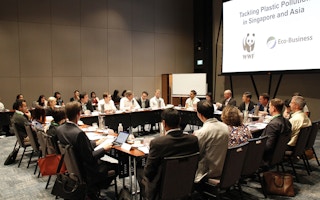NEW YORK – Too often, participants in the climate-change debate make an erroneous distinction between protecting ourselves from the longer-term impact of global warming and better preparing ourselves against today’s extreme weather events. Recent reports from the United Nations Intergovernmental Panel on Climate Change (IPCC) have sought to break down this artificial divide. While seeking to reduce greenhouse-gas emissions, we must work toward more effective disaster-risk management.
To continue reading, subscribe to Eco‑Business.
There's something for everyone. We offer a range of subscription plans.
- Access our stories and receive our Insights Weekly newsletter with the free EB Member plan.
- Unlock unlimited access to our content and archive with EB Circle.
- Publish your content with EB Premium.
Adaptation to climate change is typically associated with the “hardware” of major development projects. It aims to build resilience against the long-term impact of global warming – that is, rising sea levels, harsher winters, hotter summers, worsening drought, heavier rainfall and storms, and more.
But what is often overlooked is the “software” of disaster-risk management – our societies’ level of preparedness, including early-warning systems, education, and effective communication with the most vulnerable populations. Indeed, this aspect of climate change has recorded some remarkable successes in recent years, notably a marked decline in weather-related deaths.
“
Much of the danger lies not just in the frequent, severe, and unpredictable weather events themselves, but also in the deadly ways that these events interact with other, man-made risks
The IPCC reports remind governments and the general public that climate-change adaptation involves more than planning for changes in average temperature, sea level, and precipitation. It also requires us to reduce or manage the risks associated with changing climate activity. Much of the danger lies not just in the frequent, severe, and unpredictable weather events themselves, but also in the deadly ways that these events interact with other, man-made risks.
Humans have always been prey to nature’s force, especially along exposed coastlines, riverbanks, or hillsides. But climate change has made the floods, storms, earthquakes, heat waves, cold snaps, droughts, and landslides that mankind has come to expect much more potent. It is this vital point that the IPCC’s latest updates address in calling for disaster managers to reassess their action plans.
For example, the data for major disaster events in 2013 suggest that for the first time in many years, more people were affected by storms than by floods. Though it is too early to draw definitive conclusions, in the long run storms may contribute more significantly to the global costs of disasters, which already exceed $100 billion annually.
However, we cannot simply look to past climate events to predict future patterns. Since 2008, for example, more than 150 million people worldwide have been displaced by disasters that few predicted. And worse disasters will surely occur as the changing climate interacts with other social ills such as poverty, environmental degradation, population growth, urbanization, and poor land use.
The reality of what we face was demonstrated in two major storms last year. In October 2013, Cyclone Phailin struck India’s Odisha coastline. When a similar disaster struck in 1999, 10,000 lives were lost. Fortunately, this time the authorities and local communities were well-prepared: though 12 million people were affected by Phailin, the evacuation of one million people kept the death toll down to double digits.
Contrast that with Typhoon Haiyan, the most powerful storm ever to make landfall in the Philippines. The warming of the Pacific Ocean contributed to unprecedented seven-meter-high tidal surges. But uncertainty and inaction over Haiyan’s potential impact resulted in a death toll of nearly 6,000.
The lesson to be drawn from this tragedy is that climate change has forced us to change fundamentally the way we analyze disaster risk management. In fact, climate change essentially is about managing risk. Though the ideal long-term response would be for the world to eliminate all greenhouse-gas emissions by the end of the century, we must confront the immediate challenges of protecting the planet’s most vulnerable populations. With open discussion and a bit of ingenuity, these threats can surely be addressed.
“
Climate change essentially is about managing risk
Fortunately, the IPCC reports have generated a debate about how we should update the UN’s 2005 Hyogo Framework for Action, agreed in the wake of the 2004 Indian Ocean tsunami. We hope that this ongoing work will inform a new approach to disaster-risk management in the run-up to the UN World Conference on Disaster Risk Reduction to be held in Sendai, Japan, next March.
The Sendai Conference must be the international focal point for future policy, and it must complement the post-2015 development agenda, which will include new Sustainable Development Goals and a global agreement on reducing greenhouse-gas emissions.
It is clear that the world is not ready for the unpleasant surprises that climate change will force upon it. But, with some 70 developing countries still lacking the means to provide their citizens with basic information, such as how climate change can affect agriculture and local weather patterns, there is plenty more that we can do to reduce the risks.
Indeed, it is a matter of global urgency that all societies, rich and poor, understand how disaster-risk management operates across the full spectrum of potential threats. It is not just our future prosperity that is at stake; the world could lose the hard-won gains made in poverty reduction in recent decades.
Kristalina Georgieva is EU Commissioner for International Cooperation, Humanitarian Aid, and Crisis Response. Margareta Wahlström is Head of the UN Office for Disaster Risk Reduction. © Project Syndicate 1995–2014










